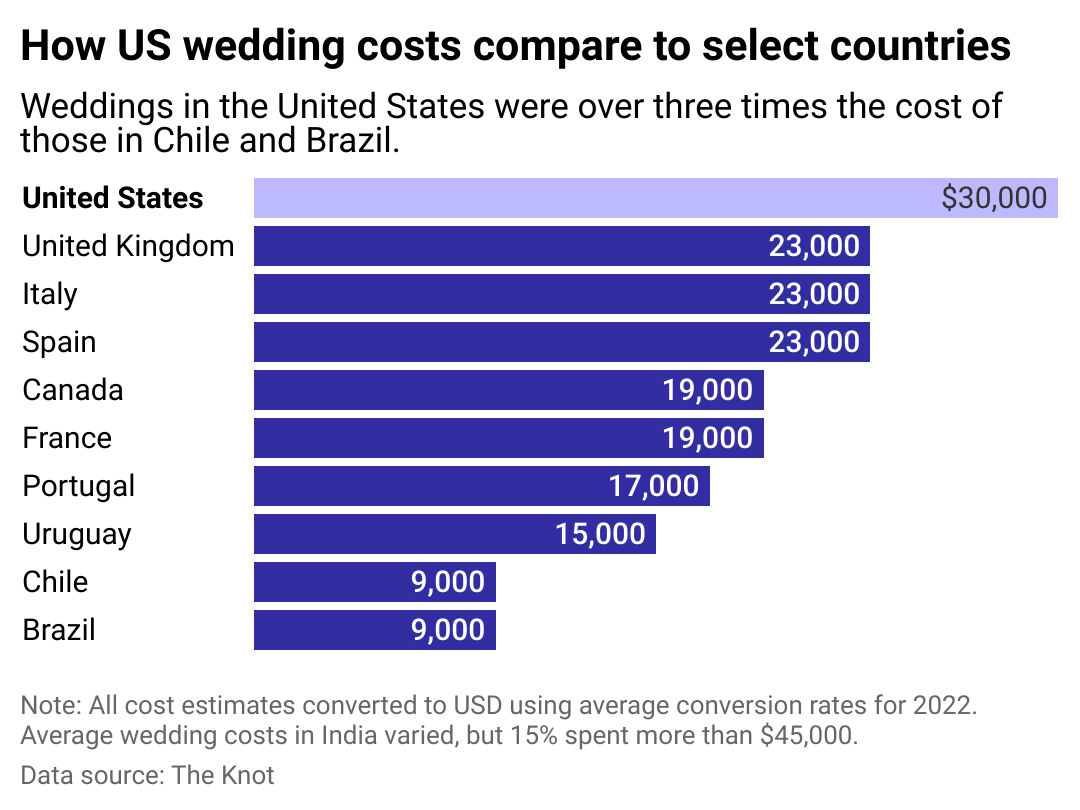How US wedding costs compare to other countries—and where spending is changing the most

Canva
How US wedding costs compare to other countries—and where spending is changing the most
A couple at their wedding looking happy.
Couples around the world want to tie the knot in a special way, whether it’s a celebration in a banquet hall in Canada, a villa in Portugal, or a lush garden in Mexico. All types of weddings—from intimate gatherings to large blow-outs—have one thing in common: a price tag. Depending on where you live, that could be a significant bill.
Americans have typically spent more on their weddings than couples in other countries. In 2023, they spent an average of $30,000, up 2.7% from 2019’s $29,200 price tag. That said, considering inflation, the actual cost of a wedding has decreased. In 2023 dollars, weddings in 2019 cost, on average, the equivalent of $35,435. In fact, wedding costs haven’t changed much for decades—an average 1990 wedding cost $35,400 in 2023 dollars, according to The Wedding Report.
The global wedding services industry is expected to reach $429.56 billion by 2030, up more than 70% since 2022, according to 360iResearch. But that cost isn’t necessarily distributed evenly by country. Peerspace looked at global wedding data from The Knot between 2019 and 2023 and reported how wedding spending in 10 major countries, including the U.S., varies and how it’s been changing.
![]()

Peerspace
US spends most on weddings, though per-guest costs in the UK are the priciest
Bar chart showing how U.S. wedding costs compare to select countries, reaching $30,000 and topping the list. Average wedding costs in India varied, but 15% spent more than $45,000 while the midpoint for educated couples was $25,000.
While Americans spend more actual dollars on their weddings, budgets in other countries have increased more dramatically. Since 2019, wedding costs have grown nearly 20% in the U.K. and 8% in France, but just 2.7% in the U.S. Some have cut their budgets—in Spain, costs are down 1.7%, and in Canada, they’re down over 13%.
Economic challenges with inflation have affected wedding’ spending. In many North and South American countries, over 40% of couples surveyed by The Knot said economic issues impacted their wedding plans. That led to increased budgets, downsized guest lists, and fewer premium options.
The trend of smaller weddings spans the globe. Compared to 2019, guest numbers for weddings in 2023 were down in every country on this list. American couples cut over 7% of their guest lists, with an average of just 117 guests. Other countries had more significant extremes—British weddings had 81 guests, a 22% decrease. Canadians sliced their guest list by over 42%, going from 154 guests to 89. Even in India, known for its giant wedding celebrations, guest numbers were down nearly 46% to 285.
Although weddings have gotten smaller, couples everywhere are lavishing more money on their guests.
Couples in the U.K. are the most generous, spending $284 per guest, while Americans spend $256 per guest. Brazilians spend the least on guests—just $72 in 2023, but that’s up nearly 74% compared to 2019.
“The pandemic shone a light on the beauty and impact of having weddings with smaller guest lists,” according to Valentina Ring, a U.K.-based international wedding planner with The Stars Inside. “Couples were keeping their budgets the same but choosing to celebrate with just their closest family and friends, thus increasing the budget per person (which is what matters!) and giving themselves permission to spend money to elevate the time spent with their nearest and dearest.”
The pandemic also changed couples’ values and priorities. Ring has seen a shift in the U.K. since 2017. Apart from more curated guest lists, couples are also “spending money in a more educated way, or ensuring their day and their team truly reflects their values,” Ring says.
According to The Knot, couples hire an average of 10 vendors for their big day. Except for the U.S., photography is the most important wedding element across these countries. Brides in the U.S. rank the dress as the most crucial element they’re shopping for, followed by photography, groom’s attire, and catering.
Flowers are a priority among the European countries in the report, except in the U.K. In Latin America, hair and makeup are another top priority. Setting the mood is also imperative in many countries—music is a top vendor in Mexico, the U.K., Spain, Italy, Portugal, Argentina, and Uruguay.
“Spend has become a bit more thoughtful and savvy since 2019, as a result of the pandemic, inflation, and the cost-of-living crisis, but for the most part, the percentages that are being allocated to each category remain similar,” Ring says, adding that couples look to save money on stationery, cake, and transportation.
Still, no matter how much they spend, couples worldwide have one thing in common: making their wedding one of the most memorable days of their lives.
Story editing by Carren Jao. Copy editing by Kristen Wegrzyn.
This story originally appeared on Peerspace and was produced and
distributed in partnership with Stacker Studio.
